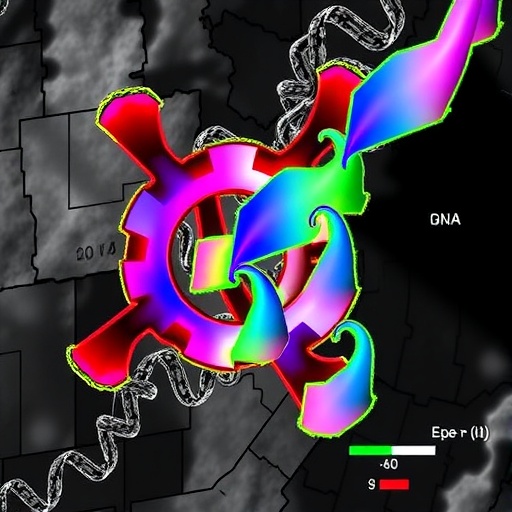In a groundbreaking advancement poised to revolutionize genome engineering, a team of researchers has unveiled a novel approach to reprogram site-specific retrotransposons for precise insertion into new DNA targets. This pioneering technique, detailed in a recent study published in Nature, harnesses the natural targeting mechanisms of retroelements while marrying them to the precision of CRISPR technology, ushering in a new era of scarless, efficient, and programmable genome integration.
Retroelements are mobile genetic elements that propagate through a copy-and-paste mechanism involving reverse transcription. Among these, site-specific non-long terminal repeat (non-LTR) retrotransposons have long fascinated scientists due to their ability to integrate preferentially into repetitive genomic regions. Classic examples include their targeting of microsatellites and ribosomal DNA genes, which are known hotspots within eukaryotic genomes. This specificity has intrigued geneticists, but the limitations imposed by their natural targeting preferences have historically curtailed their utility for custom genome engineering applications.
The current study addresses these limitations by discovering multiple new families of site-specific retrotransposons using a sophisticated computational pipeline. This approach enabled the identification and biochemical profiling of R2 retrotransposon variants across diverse species, including the zebra finch (Taeniopygia guttata). Key among these discoveries is R2^Tg, an orthologue demonstrating the remarkable ability to be reprogrammed through engineered payloads. The researchers demonstrated that R2^Tg could execute targeted DNA cleavage, reverse transcription, and scarless insertions, thereby opening the door for precise integration of heterologous sequences at novel genomic loci.
Further screening efforts led to the isolation of another potent R2 orthologue, R2^Tocc, distinguished by its natural reprogrammability and reduced insertion activity at its native 28S ribosomal DNA target. Integrating R2^Tocc with a SpCas9^H840A nickase generated the engineered system termed STITCHR: site-specific target-primed insertion through targeted CRISPR homing of retroelements. STITCHR exemplifies a modular platform capable of installing edits on a grand scale, ranging from single nucleotide changes to large insertions exceeding 12 kilobases. Notably, it supports payload delivery using either in vitro transcribed RNA or synthetic RNA templates, broadening its applicability across various experimental contexts.
This breakthrough transcends existing genome editing modalities, offering several key advantages. Unlike many integrative approaches, STITCHR performs scarless insertions, leaving no residual sequence ‘scars’ that can disrupt gene function or regulation. Moreover, its ability to operate effectively in both dividing and non-dividing cells addresses a significant limitation faced by traditional gene editing technologies, many of which rely on cell cycle-dependent mechanisms for DNA repair and integration.
Beyond fundamental research, the implications of this technology for therapeutics are profound. Site-specific and scarless integration is a holy grail for gene therapy, where unpredictable insertional mutagenesis and off-target effects have been long-standing concerns. The programmable nature of STITCHR promises to enable precise gene replacement, correction of pathogenic mutations, and delivery of large therapeutic gene cassettes with unprecedented control and safety.
At the mechanistic level, this work sheds light on the evolutionary plasticity of retrotransposon targeting preferences. The natural specificity for repetitive sequences such as rDNA was historically thought to be a hardwired barrier. However, the study reveals that certain R2 family members retain inherent reprogrammability, suggesting potential natural avenues for retargeting through payload engineering. This insight challenges preconceived notions and opens up novel exploration paths to harness retroelements as versatile genome engineering platforms.
From a technical perspective, the integration of CRISPR nickases with retrotransposon reverse transcriptase activity is an elegant solution to the challenge of modular retargeting. Cas9 nickases generate single-strand breaks, which appear to effectively prime the reverse transcription and insertion machinery of the retrotransposon. This fine-tuning circumvents the deleterious double-strand breaks typically associated with conventional CRISPR-Cas9, thereby reducing cytotoxicity and increasing editing efficiency.
Furthermore, the discovery that large payloads, including gene replacements spanning over 12.7 kilobases, can be integrated scarlessly sets STITCHR apart from other insertion technologies that either struggle with payload size or leave behind disruptive sequence motifs. This feature notably expands the therapeutic landscape, where large gene constructs or complex regulatory elements are often required.
The study’s multidimensional approach—combining computational genomics, molecular engineering, and mammalian cell assays—exemplifies the power of interdisciplinary strategies in biotechnology development. By uncovering and exploiting the natural diversity of retrotransposon orthologues, the researchers have constructed a versatile toolbox ready for fine-tuned genome writing across a wide range of biological systems.
Looking forward, the adaptation of STITCHR for in vivo applications promises exciting opportunities. Tailoring programmable, scarless, and efficient insertion systems for tissues and organs resistant to conventional editing could revolutionize gene therapy for genetic diseases, cancer, and regenerative medicine. Additionally, the potential for deploying this technology in non-dividing cells such as neurons opens new frontiers in neuroscience and cell biology research.
In summary, the development of STITCHR marks a transformative step in genome engineering, marrying the natural precision of retrotransposons with the programmability of CRISPR technology. This innovative platform achieves efficient, scarless, and programmable DNA integration, breaking new ground beyond existing gene editing tools. As the scientific community continues to explore and refine this versatile system, its impact is anticipated to ripple through both fundamental biological research and clinical therapeutics, heralding a new era of genomic medicine.
Subject of Research: Site-specific retrotransposon reprogramming and programmable scarless genome integration using engineered retrotransposon-CRISPR fusion systems.
Article Title: Reprogramming site-specific retrotransposon activity to new DNA sites.
Article References:
Fell, C.W., Villiger, L., Lim, J. et al. Reprogramming site-specific retrotransposon activity to new DNA sites. Nature (2025). https://doi.org/10.1038/s41586-025-08877-4
Image Credits: AI Generated
Tags: biochemical profiling techniquesCRISPR technology applicationseukaryotic genome integrationgenome engineering advancementsmicrosatellites in geneticsmobile genetic elements researchnovel retrotransposon familiesprogrammable genome integrationR2 retrotransposon variantsretargeting retrotransposonsretroelements in geneticssite-specific DNA insertion





